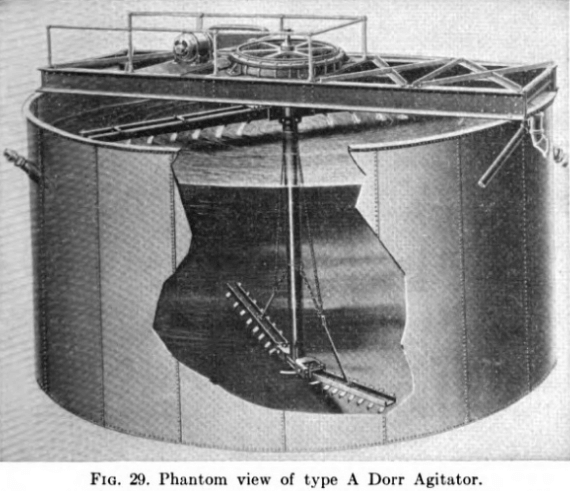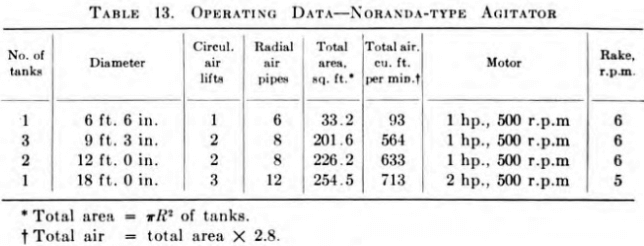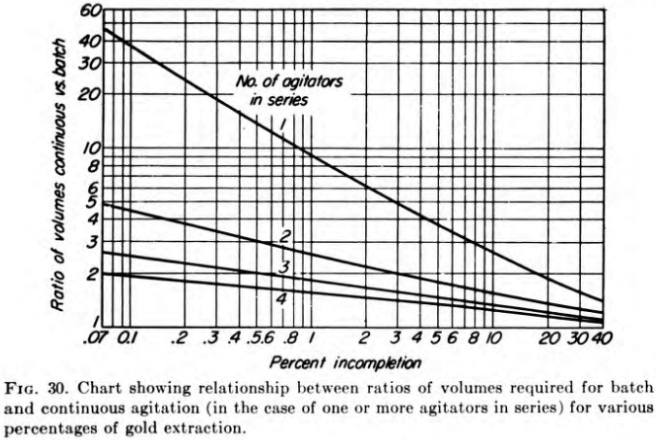Table of Contents
The mixing of solids suspended in a fluid medium is still largely an art. The development of fundamental laws governing the operation is complicated by the large number of variables involved, some of which can hardly be evaluated in mathematical terms.
Practical studies of the circulation patterns of the more common types of agitators are to be found in chemical engineering literature. In one of the more recent articles on this subject the author summarises a few rules for agitator design as follows:
For ratio of tank diameter divided by impeller diameter, take 4:1 for simple blending of light material; 3:1 for the average job, and 2:1 for heavier density or high viscosity material. The approximate impeller speed should be 700 peripheral feet per minute for turbine-type impellers and 1000 to 1500 ft. per min. for the propeller type. The horsepower requirements can be estimated from data given in the various engineering handbooks.
Because in certain cases power input appears to be directly related to agitator performance, i.e., in gas absorption and emulsification, a rather intensive study has been made of the problem. Thomas Hooker investigated the power function M versus agitator Reynolds number Re. Secondary dimensions such as pitch, liquid depth, and blade width were expressed on a dimensionless basis by dividing by the primary dimension of the agitator span L. The standard systems chosen for this work were those involving axial flow, tangential flow, and radial flow, and plots showing the above relationship for each system are given, in addition, to a number of the design-factor plots. It is suggested that the agitator power consumption can be predicted for most installations to within ± 20 per cent using this method.
An earlier paper reports the results of experimental work on the effect of the number, size, and position of baffles on agitator power consumption. The so-called fully baffled condition, when the input reaches a maximum, is discussed.
In cyanidation leaching work, however, it is evident that agitation has two purposes only:
- to keep the solids in suspension while dissolution is taking place and
- to supply the required amount of oxygen.
Violent agitation has no recognised value in itself, but ample oxygen supply is essential to promote the reaction between gold, silver, and cyanide. Control of aeration during agitation is essential, since excessive aeration usually results in greater consumption of lime and sometimes of cyanide, with no increase in extraction.
Length of contact and dilution during agitation vary considerably for different ores. For gold ores agitation periods vary from 16 to 48 hr., probably averaging 30 hr., and for silver ores nearly twice this period. Dilution during agitation varies from 1 of solution to 1 of solids by weight to 3 of solution to 1 of solids, occasionally higher, probably averaging 2 to 1. Operation is continuous through a series of agitators, preferably three or more, to minimize any tendency for short-circuiting. Change of solution during agitation by means of a thickener placed between agitators often improves extraction, particularly when silver or other ores requiring long periods of agitation are being treated.
Three types of agitators are now in general use: mechanical types (Devereux, Turbo, Wallace); air-lift types (Pachuca, Parral); air- mechanical type (Dorr, and Noranda type).
Mechanical Agitators
The first agitators used in the industry were of the simple rotating-paddle type. These, however, required a large amount of power and did not give uniform suspension or satisfactory means for controlling aeration in cyanidation leaching.
Devereux. The Devereux is a propeller-type agitator in which a propeller revolving centrally in a round, flat-bottomed tank at about one-third the depth of the tank above the bottom forces the pulp downward to the bottom where it is deflected along the bottom and up the tank sides, creating a vortex at the center in which air is drawn into the pulp. This machine, while simple mechanically, requires relatively high power. At one plant an 18- by 18-ft. Devereux requires 15 hp. when agitating a pulp containing 62 per cent solids.
Turbo and Wallace. The Turbo and the Wallace are high-speed impeller types of agitator imparting high velocity to the pulp and are suited for relatively small-diameter flat-bottomed tanks. The Turbo may be provided with an impeller near the pulp surface whereby large amounts of free air may be drawn into the pulp and emulsified.
The Wallace consists essentially of an impeller or rotor near the tank bottom and at the lower end of a stationary vertical pipe which extends nearly to the pulp surface. The action of the impeller creates a circulation of pulp down the pipe and into the impeller. When the pipe is properly placed, free air is drawn into the top of the pipe together with pulp and disseminated throughout the tank. The pipe may have auxiliary openings to draw in pulp from different levels in the tank.
Both of these agitators have been used in combination with Dorr agitators for supplying large quantities of air to the pulp when treating ores or concentrate requiring an unusual degree of aeration.
Pachuca Leaching Tank
The Brown or Pachuca agitator, as it is most commonly known, originated in New Zealand in the early days of cyanidation leaching, the invention of F. C. Brown. It later became popular in Mexico, and to a limited extent its use has spread to other countries.
The Pachuca agitator is an all-air agitator which consists of a central stationary air-lift pipe in a circular cone-bottomed tank of varying dimensions, usually from 5 to 18 ft. in diameter and 20 to 60 ft. in depth.

Relatively large quantities of high-pressure air are required, and with some ores considerable difficulty results from the building up and sloughing off of solid masses from the tank sides. The height of the Pachuca is a further disadvantage and usually necessitates pumping of the pulp.
The Pachuca agitator is still to a large extent retained on the Rand, about one-half of the continuous-treatment slime plants using it in their flow sheets. A recent paper states “where maximum aeration of pulp is essential for optimum extraction, it appears that the Brown tank (Pachuca) is superior (to the Dorr) in maintaining the oxygen content of the pulp at a higher level.” This statement is based on some recent work at the the Geduld Propietory mines and the Sub Nigel, Ltd., but tests made in the early 1920’s indicated that, if additional aeration is supplied to the submerged rake arms, the Dorr agitator can be made as effective an aerator as the Pachuca and at a lower operating cost owing to lower total air requirements and the fact that it is not necessary to elevate the pulp.
The Dorr Leaching Agitator
The Dorr agitator, in general use today, is a combination mechanical and air agitator designed for use in round, flat- bottomed tanks as large as 50 ft. in diameter and 25 ft. in depth.
The pulp and coarse solids from the bottom of the tank are elevated by means of air through the revolving hollow central shaft to a head casting above the pulp level and thence distributed through two revolving launders over the surface of the pulp. Coarse solids settling on the bottom of the tank are raked to the central lift by two plow arms attached to the shaft.
The rate of circulation in the tank is controlled by means of the air supply to the central lift.

Air is absorbed in the solution both from the air lift and from the series of pulp streams plunging into the surface of the pulp from the distributing launders.
Figure 29 shows the more recent type of Dorr agitator with I-beam supports, which requires minimum headroom and makes for ready accessibility.
The power required for both mechanical operation and air for agitators from 12 to 40 ft. in diameter will vary from about 1.0 to 0.5 hp. per 1000 cu. ft. of capacity.
Noranda Type
This agitator was developed at Noranda mines to handle the heavy sulphide concentrates which required also a high degree of aeration for optimum extraction and economy in reagents. In this machine the settled sands raked to the center of the relatively deep tank are returned to the top of the agitator by an outside air lift while additional aeration is supplied by a series of jets placed around the tank and connected to a circular header above. Tank areas and total air supply are given in Table 13.
Air is supplied to the agitators at 10 lb. per sq. in. This pressure was selected because it appears to give satisfactory oxygenation at relatively low cost.

Continuous Versus Batch Agitation Leaching
A common problem in mill design is to determine from the experimental data obtained by batch tests the number and capacity of agitators that must be used in a continuous system in order to approximate the same degree of dissolution.
A mathematical analysis of this problem is described by McMullin and Weber in Trans. 31, A.I.Ch.E409, 1935.
As a result of further studies along these lines, Dr. E. J. Roberts has prepared the graph shown in Fig. 30, which expresses the relationship between the ratio of volumes for continuous and batch systems and the percentage of in-completion of the reaction for series of one to four agitators.
Commenting on this relationship, Dr. Roberts points out that the numerical values obtained should be taken for general guidance only because the assumptions involved in the calculations are first approximations only based on the hypothesis that the rate of dissolution is a function of the continuously diminishing surface of the substance being dissolved. In the case of the extraction of gold by cyanide solution, it is probable that other factors such as the rate of diffusion through pores in the rock particles, intensity of agitation, etc., affect the over-all rate of dissolution. For precise design, therefore, it is recommended that the MacMullin method be followed, which involves running tests to determine the type of reaction empirically.
As an example of how Fig. 30 may be used, take the case of gold being dissolved by cyanide solution. Assume 98 per cent completion of reaction is desired, or 2 per cent in-completion. Referring to the graph, the required reaction could be completed in one agitator if the volume relationship was 6 to 1. In other words, if 10 hr. was required by batch agitation to extract 98 per cent of the gold which could be extracted in infinite time, a single continuous agitator would have to be large enough to give 60-hr. detention time. However, if two agitators were used in series, the combined volumes would have to be large enough to give only 21.6-hr. detention, while in the case of three agitators in series the time is reduced to 16.4 hr., or 5.5 hr. for each agitator.

In actual practice, an economic balance covering first cost and operating costs for the various combinations of agitators indicated would have to be worked out and the most favorable of these selected.
